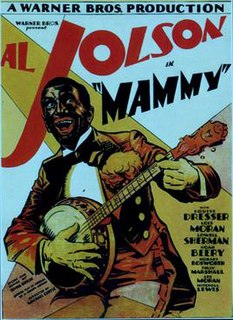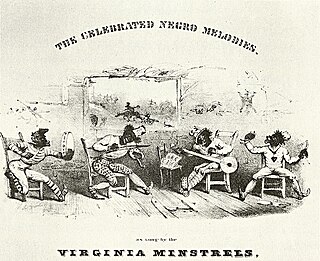
Blackface is a form of theatrical make-up used predominantly by non-black performers to represent a caricature of a black person. The practice gained popularity during the 19th century and contributed to the spread of racial stereotypes such as the "happy-go-lucky darky on the plantation" or the "dandified coon". By the middle of the century, blackface minstrel shows had become a distinctive American artform, translating formal works such as opera into popular terms for a general audience. Early in the 20th century, blackface branched off from the minstrel show and became a form in its own right. In the United States, blackface had largely fallen out of favor by the turn of the 21st century, and is now generally considered offensive and disrespectful, though the practice continues in other countries.

The Black and White Minstrel Show is a British light entertainment show that ran for twenty years on BBC prime-time television. Beginning in 1958, it was a weekly light entertainment and variety show which presented traditional American minstrel and country songs, as well as show tunes and music hall numbers, and with lavish costumes. It was also a popular stage show.

Minstrel in the Gallery is the eighth studio album by British band Jethro Tull, recorded in April and released in September 1975. The album goes in a different direction from their previous work War Child (1974), with the orchestration being replaced by a string quartet conducted by David Palmer. The band also returned to the blend of electric and acoustic pieces, in a manner closer to their early '70s albums such as Benefit (1970), Aqualung (1971) and Thick as a Brick (1972), and for the first time since their two concept albums of Thick as a Brick (1972) and A Passion Play (1973), they recorded a song of more than ten minutes, which occupies almost all of the second side of the record.

The Minstrel was a Canadian-bred, Irish-trained Thoroughbred racehorse and sire. Bred in Ontario, he was sold as a yearling and exported to Europe, where he was campaigned in Ireland and the United Kingdom. As a two-year-old The Minstrel was unbeaten in three races including the Dewhurst Stakes, but lost two of his first three starts in 1977. He was then moved up in distance and won his remaining three races: the Epsom Derby, the Irish Derby, and the King George VI and Queen Elizabeth Stakes.

Once Upon a Mattress is a musical comedy with music by Mary Rodgers, lyrics by Marshall Barer, and book by Jay Thompson, Dean Fuller, and Marshall Barer. It opened off-Broadway in May 1959, and then moved to Broadway. The play was written as an adaptation of the Hans Christian Andersen fairy tale The Princess and the Pea.
The New Christy Minstrels are an American large-ensemble folk music group founded by Randy Sparks in 1961. From their beginnings as prominent figures in the early-1960s U.S. folk revival, the group recorded over 20 albums and had several hits, including "Green, Green", "Saturday Night", "Today", "Denver", and "This Land Is Your Land". Their 1962 debut album, Presenting The New Christy Minstrels won a Grammy Award and sat in the Billboard charts for two years.

Christy's Minstrels, sometimes referred to as the Christy Minstrels, were a blackface group formed by Edwin Pearce Christy, a well-known ballad singer, in 1843, in Buffalo, New York. They were instrumental in the solidification of the minstrel show into a fixed three-act form. The troupe also invented or popularized "the line", the structured grouping that constituted the first act of the standardized three-act minstrel show, with the interlocutor in the middle and "Mr. Tambo" and "Mr. Bones" on the ends.
"Gwine to Run All Night, or De Camptown Races" is a minstrel song by Stephen Foster (1826–1864). It was published in February 1850 by F. D. Benteen of Baltimore, Maryland, and Benteen published a different version with guitar accompaniment in 1852 under the title "The Celebrated Ethiopian Song/Camptown Races". The song quickly entered the realm of popular Americana. In 1909, composer Charles Ives incorporated the tune and other vernacular American melodies into his orchestral Symphony No. 2.

"Dixie", also known as "Dixie's Land", "I Wish I Was in Dixie", and other titles, is a popular song in the Southern United States. It is one of the most distinctively Southern musical products of the 19th century and probably the best-known song to have come out of blackface minstrelsy. It was not a folk song at its creation, but it has since entered the American folk vernacular. The song likely cemented the word "Dixie" in the American vocabulary as a nickname for the Southern United States. Most sources credit Ohio-born Daniel Decatur Emmett with the song's composition, although other people have claimed credit, even during Emmett's lifetime. Compounding the problem are Emmett's own confused accounts of its writing and his tardiness in registering its copyright. The latest challenge has been made on behalf of the Snowden Family Band of Knox County, Ohio, who may have collaborated with Emmett to write "Dixie".

The Magic Cloak of Oz is a 1914 film directed by J. Farrell MacDonald. It was written by L. Frank Baum and produced by Baum and composer Louis F. Gottschalk. The film is an adaptation of Baum's novel, Queen Zixi of Ix.
Tudor Minstrel (1944–1971) was a British-bred Champion Thoroughbred racehorse. In a career which lasted from the spring of 1946 until September 1947 he ran ten times and won eight races. He was unbeaten in four races in 1946, a year in which he was the highest-rated two-year-old in Britain, despite ending his season in July. The following year he won the 2,000 Guineas, St. James's Palace Stakes and Knights Royal Stakes over one mile but was beaten in his two attempts at longer distances, most notably when starting odds-on favourite for the 1947 Epsom Derby.

Mammy (1930) is an American pre-Code musical drama film with Technicolor sequences, released by Warner Bros. The film starred Al Jolson and was a follow-up to his previous film, Say It with Songs (1929). Mammy became Al Jolson's fourth feature, following earlier screen efforts as The Jazz Singer (1927), The Singing Fool (1928) and Say It with Songs (1929). The movie relives Jolson's early years as a minstrel man. The songs were written by Irving Berlin, who is also credited with the original story titled Mr. Bones.
The Nancy Drew Mystery Stories is the long-running "main" Nancy Drew series, which was published under the pseudonym Carolyn Keene. There are 175 novels — plus 34 revised stories — that were published between 1930 and 2003 under the banner; Grosset & Dunlap published the first 56, and 34 revised stories, while Simon & Schuster published the series beginning with volume 57.

Minstrel in the Galaxy is an album by Acid Mothers Temple & The Melting Paraiso U.F.O., released in 2004 by Riot Season. This was the first Acid Mothers Temple album not to feature Cotton Casino on vocals, instead featuring Afrirampo members, Oni & Pikacyu. The album title is a play on the name of the Jethro Tull album Minstrel in the Gallery.
The Northumbrian Minstrel is a songbook, giving the lyrics of local, now historical songs, printed and published at Alnwick in 1811 by William Davison. The majority of the songs are written by songwriters from the North of the County, and therefore the content differs from most of the other popular Northumbrian chapbooks.











